Annual plant reviews volume 40 biochemistry of plant secondary metabolism second edition
Bạn đang xem bản rút gọn của tài liệu. Xem và tải ngay bản đầy đủ của tài liệu tại đây (12.97 MB, 477 trang )
fm
BLBK250-Wink
March 3, 2010
11:20
Char Count=
ANNUAL PLANT REVIEWS
VOLUME 40
Biochemistry of Plant Secondary Metabolism: Second Edition Edited by Michael Wink
© 2010 Blackwell Publishing Ltd. ISBN: 978-1-405-18397-0
i
fm
BLBK250-Wink
March 3, 2010
11:20
Char Count=
ANNUAL PLANT REVIEWS
VOLUME 40
Biochemistry of Plant
Secondary Metabolism
Second Edition
Edited by
Michael Wink
Professor of Pharmaceutical Biology
Institute of Pharmacy and Molecular Biotechnology
Heidelberg University
Germany
A John Wiley & Sons, Ltd., Publication
iii
fm
BLBK250-Wink
March 3, 2010
11:20
Char Count=
This edition first published 2010
c 2010 Blackwell Publishing Ltd.
Blackwell Publishing was acquired by John Wiley & Sons in February 2007. Blackwell’s
publishing programme has been merged with Wiley’s global Scientific, Technical, and
Medical business to form Wiley-Blackwell.
Registered office
John Wiley & Sons Ltd, The Atrium, Southern Gate, Chichester, West Sussex, PO19 8SQ,
United Kingdom
Editorial offices
9600 Garsington Road, Oxford, OX4 2DQ, United Kingdom
2121 State Avenue, Ames, Iowa 50014-8300, USA
For details of our global editorial offices, for customer services and for information about
how to apply for permission to reuse the copyright material in this book please see our
website at www.wiley.com/wiley-blackwell.
The right of the author to be identified as the author of this work has been asserted in
accordance with the UK Copyright, Designs and Patents Act 1988.
All rights reserved. No part of this publication may be reproduced, stored in a retrieval
system, or transmitted, in any form or by any means, electronic, mechanical,
photocopying, recording or otherwise, except as permitted by the UK Copyright, Designs
and Patents Act 1988, without the prior permission of the publisher.
Wiley also publishes its books in a variety of electronic formats. Some content that
appears in print may not be available in electronic books.
Designations used by companies to distinguish their products are often claimed as
trademarks. All brand names and product names used in this book are trade names,
service marks, trademarks or registered trademarks of their respective owners. The
publisher is not associated with any product or vendor mentioned in this book. This
publication is designed to provide accurate and authoritative information in regard to the
subject matter covered. It is sold on the understanding that the publisher is not engaged
in rendering professional services. If professional advice or other expert assistance is
required, the services of a competent professional should be sought.
Library of Congress Cataloging-in-Publication Data
Biochemistry of plant secondary metabolism / edited by Michael Wink. – 2nd ed.
p. cm. – (Annual plant reviews ; v. 40)
Includes bibliographical references and index.
ISBN 978-1-4051-8397-0 (hardback : alk. paper) 1. Plants–Metabolism.
2. Metabolism, Secondary. 3. Botanical chemistry. I. Wink, Michael.
QK881.B54 2010
572 .42–dc22
2009038730
A catalogue record for this book is available from the British Library.
Set in 10/12 pt Palatino by Aptara R Inc., New Delhi, India
Printed in Singapore
1
2010
iv
fm
BLBK250-Wink
March 3, 2010
11:20
Char Count=
Annual Plant Reviews
A series for researchers and postgraduates in the plant sciences. Each volume
in this series focuses on a theme of topical importance and emphasis is placed
on rapid publication.
Editorial Board:
Prof. Jeremy A. Roberts (Editor-in-Chief), Plant Science Division, School of
Biosciences, University of Nottingham, Sutton Bonington Campus,
Loughborough, Leicestershire, LE12 5RD, UK;
Dr David Evans, School of Biological and Molecular Sciences, Oxford
Brookes University, Headington, Oxford, OX3 0BP;
Prof. Hidemasa Imaseki, Obata-Minami 2419, Moriyama-ku, Nagoya 463,
Japan;
Dr Michael T. McManus, Institute of Molecular BioSciences, Massey
University, Palmerston North, New Zealand;
Dr Jocelyn K.C. Rose, Department of Plant Biology, Cornell University,
Ithaca, New York 14853, USA.
Titles in the series:
1. Arabidopsis
Edited by M. Anderson and J.A. Roberts
2. Biochemistry of Plant Secondary Metabolism
Edited by M. Wink
3. Functions of Plant Secondary Metabolites and Their Exploitation in
Biotechnology
Edited by M. Wink
4. Molecular Plant Pathology
Edited by M. Dickinson and J. Beynon
5. Vacuolar Compartments
Edited by D.G. Robinson and J.C. Rogers
6. Plant Reproduction
Edited by S.D. O’Neill and J.A. Roberts
7. Protein–Protein Interactions in Plant Biology
Edited by M.T. McManus, W.A. Laing and A.C. Allan
8. The Plant Cell Wall
Edited by J.K.C. Rose
9. The Golgi Apparatus and the Plant Secretory Pathway
Edited by D.G. Robinson
10. The Plant Cytoskeleton in Cell Differentiation and Development
Edited by P.J. Hussey
11. Plant–Pathogen Interactions
Edited by N.J. Talbot
12. Polarity in Plants
Edited by K. Lindsey
13. Plastids
Edited by S.G. Moller
14. Plant Pigments and Their Manipulation
Edited by K.M. Davies
15. Membrane Transport in Plants
Edited by M.R. Blatt
v
fm
BLBK250-Wink
March 3, 2010
11:20
Char Count=
16. Intercellular Communication in Plants
Edited by A.J. Fleming
17. Plant Architecture and Its Manipulation
Edited by C.G.N. Turnbull
18. Plasmodesmata
Edited by K.J. Oparka
19. Plant Epigenetics
Edited by P. Meyer
20. Flowering and Its Manipulation
Edited by C. Ainsworth
21. Endogenous Plant Rhythms
Edited by A. Hall and H. McWatters
22. Control of Primary Metabolism in Plants
Edited by W.C. Plaxton and M.T. McManus
23. Biology of the Plant Cuticle
Edited by M. Riederer
24. Plant Hormone Signaling
Edited by P. Hadden and S.G. Thomas
25. Plant Cell Separation and Adhesion
Edited by J.R. Roberts and Z. Gonzalez-Carranza
26. Senescence Processes in Plants
Edited by S. Gan
27. Seed Development, Dormancy and Germination
Edited by K.J. Bradford and H. Nonogaki
28. Plant Proteomics
Edited by C. Finnie
29. Regulation of Transcription in Plants
Edited by K. Grasser
30. Light and Plant Development
Edited by G. Whitelam
31. Plant Mitochondria
Edited by D.C. Logan
32. Cell Cycle Control and Plant Development
Edited by D. Inz’e
33. Intracellular Signaling in Plants
Edited by Z. Yang
34. Molecular Aspects of Plant Disease Resistance
Edited by Jane Parker
35. Plant Systems Biology
Edited by G. Coruzzi and R. Guti’errez
36. The Moss Physcomitrella Patens
Edited by C.D. Knight, P.-F. Perroud and D.J. Cove
37. Root Development
Edited by Tom Beeckman
38. Fruit Development and Seed Dispersal
Edited by Lars Østergaard
39. Function and Biotechnology of Plant Secondary Metabolites
Edited by M. Wink
40. Biochemistry of Plant Secondary Metabolism
Edited by M. Wink
vi
fm
BLBK250-Wink
March 3, 2010
11:20
Char Count=
CONTENTS
Contributors
Preface
1 Introduction: biochemistry, physiology and ecological
functions of secondary metabolites
Michael Wink
1.1
1.2
1.3
1.4
1.5
Introduction
Biosynthesis
Transport, storage and turnover
Costs of secondary metabolism
Ecological role of secondary metabolites
References
2 Biosynthesis of alkaloids and betalains
Margaret F. Roberts, Dieter Strack and Michael Wink
2.1 Introduction
2.2 Nicotine and tropane alkaloids
2.3 Pyrrolizidine alkaloids (PAs)
2.4 Benzylisoquinoline alkaloids
2.5 Monoterpene indole alkaloids (MIA)
2.6 Ergot alkaloids
2.7 Acridone alkaloid biosynthesis
2.8 Purine alkaloids
2.9 Taxol
2.10 Betalains
2.11 Conclusions
References
3 Biosynthesis of cyanogenic glycosides, glucosinolates and
non-protein amino acids
Dirk Selmar
3.1
3.2
3.3
3.4
Introduction
Cyanogenic glycosides
Glucosinolates
Non-protein amino acids
Acknowledgements
References
x
xiii
1
1
2
9
13
14
17
20
20
23
33
35
46
56
60
61
62
66
75
75
92
93
94
128
146
157
157
vii
fm
BLBK250-Wink
viii
4
7
Char Count=
Biosynthesis of phenylpropanoids and related compounds
Maike Petersen, Joachim Hans and Ulrich Matern
182
4.1
4.2
182
Introduction
General phenylpropanoid pathway and formation of
hydroxycinnamate conjugates
Coumarins
Lignans
Gallotannins and ellagitannins
Conclusion
References
Biochemistry of terpenoids: monoterpenes, sesquiterpenes
and diterpenes
Mohamed Ashour, Michael Wink and Jonathan Gershenzon
5.1
5.2
5.3
5.4
6
11:20
Contents
4.3
4.4
4.5
4.6
5
March 3, 2010
Introduction
Function
Biosynthesis
Conclusions
References
Biochemistry of sterols, cardiac glycosides, brassinosteroids,
phytoecdysteroids and steroid saponins
Wolfgang Kreis and Frieder Muller-Uri
¨
6.1 Introduction
6.2 Sterols
6.3 Cardiac glycosides
6.4 Brassinosteroids
6.5 Phytoecdysteroids
6.6 Steroid saponins and steroid alkaloids
6.7 Conclusions
References
Chemotaxonomy seen from a phylogenetic perspective and
evolution of secondary metabolism
Michael Wink, Flavia Botschen, Christina Gosmann, Holger Scha¨ fer
and Peter G. Waterman
7.1
7.2
7.3
7.4
7.5
Introduction
Establishment of chemotaxonomy as a research discipline
Developments in small molecule chemotaxonomy over
the past 35 years
Molecular biology and plant taxonomy
Comparison between patterns of secondary metabolites
and molecular phylogeny
183
197
209
223
229
230
258
259
260
263
285
286
304
305
308
319
336
341
343
347
348
364
365
365
380
382
383
fm
BLBK250-Wink
March 3, 2010
11:20
Char Count=
Contents
7.6
Evolution of plant secondary metabolism
Acknowledgements
References
Index
Color plate can be found between pages 368 and 369.
ix
406
426
426
434
fm
BLBK250-Wink
March 3, 2010
11:20
Char Count=
CONTRIBUTORS
Mohamed Ashour
Institute of Pharmacy and Molecular Biotechnology
Heidelberg University
Heidelberg
Germany
Flavia Botschen
Institute of Pharmacy and Molecular Biotechnology
Heidelberg University
Heidelberg
Germany
Jonathan Gershenzon
Max-Planck-Institute of Chemical Ecology
Jena
Germany
Christina Gosmann
Institute of Pharmacy and Molecular Biotechnology
Heidelberg University
Heidelberg
Germany
Joachim Hans
Institute of Pharmaceutical Biology
Philips-University Marburg
Marburg
Germany
Wolfgang Kreis
Institute of Botany and Pharmaceutical Biology
¨
University Erlangen-Nurnberg
Erlangen
Germany
x
fm
BLBK250-Wink
March 3, 2010
11:20
Char Count=
Contributors
Ulrich Matern
Institute of Pharmaceutical Biology
Philips-University Marburg
Marburg
Germany
Maike Petersen
Institute of Pharmaceutical Biology
Philips-University Marburg
Marburg
Germany
Margaret F. Roberts
Retired from The School of Pharmacy
University of London
London
United Kingdom
Holger Sch¨afer
Institute of Pharmacy and Molecular Biotechnology
Heidelberg University
Heidelberg
Germany
Dirk Selmar
Institute of Plant Biology
Technical University Braunschweig
Braunschweig
Germany
Dieter Strack
Department of Secondary Metabolism
Institute of Plant Biochemistry
Halle
Germany
¨
Frieder Muller-Uri
Institute of Botany and Pharmaceutical Biology
¨
University Erlangen-Nurnberg
Erlangen
Germany
xi
fm
BLBK250-Wink
xii
March 3, 2010
11:20
Char Count=
Contributors
Peter G. Waterman
Retired from Centre for Phytochemistry
Southern Cross University
NSW
Australia
Michael Wink
Institute of Pharmacy and Molecular Biotechnology
Heidelberg University
Heidelberg
Germany
fm
BLBK250-Wink
March 3, 2010
11:20
Char Count=
PREFACE
A characteristic feature of plants is their capacity to synthesize and store a
wide variety of low molecular weight compounds, the so-called secondary
metabolites (SMs) or natural products. The number of described structures
exceeds 100 000; the real number in nature is certainly much higher because
only 20–30% of plants have been investigated in phytochemistry so far. In
contrast to primary metabolites, which are essential for the life of every plant,
the individual types of SMs usually occur in a limited number of plants,
indicating that they are not essential for primary metabolism, i.e. anabolism
or catabolism.
Whereas SMs had been considered to be waste products or otherwise useless compounds for many years, it has become evident over the past three
decades that SMs have important roles for the plants producing them: they
may function as signal compounds within the plant, or between the plant
producing them and other plants, microbes, herbivores, predators of herbivores, pollinating or seed-dispersing animals. More often SMs serve as defence chemicals against herbivorous animals (insects, molluscs, mammals),
microbes (bacteria, fungi), viruses or plants competing for light, water and
nutrients. Therefore, SMs are ultimately important for the fitness of the plant
producing them. Plants usually produce complex mixtures of SMs, often
representing different classes, such as alkaloids, phenolics or terpenoids. It is
likely that the individual components of a mixture can exert not only additive
but certainly also synergistic effects by attacking more than a single molecular target. Because the structures of SMs have been shaped and optimized
during more than 500 million years of evolution, many of them exert interesting biological and pharmacological properties which make them useful for
medicine or as biorational pesticides.
In this volume of Annual Plant Reviews, we have tried to provide an
up-to-date survey of the biochemistry and physiology of plant secondary
metabolism. A companion volume – M. Wink (ed.) Functions of Plant Secondary
Metabolites and Biotechnology – published simultaneously provides overviews
of the modes of action of bioactive SMs and their use in pharmacology as
molecular probes, in medicine as therapeutic agents and in agriculture as
biorational pesticides.
In order to understand the importance of SMs for plants, we need detailed
information on the biochemistry of secondary metabolism and its integration into the physiology and ecology of plants. Important issues include
xiii
fm
BLBK250-Wink
xiv
March 3, 2010
11:20
Char Count=
Preface
characterization of enzymes and genes of corresponding biosynthetic pathways, and of transport and storage mechanisms, regulation in space/time
and compartmentation of both biosynthesis and storage. The study of secondary metabolism has profited largely from the recent progress in molecular
biology and cell biology and the diverse genome projects. Although Arabidopsis thaliana is not an excellent candidate to study secondary metabolism on
the first view, the genomic analyses, EST-libraries, mutants and other tools of
A. thaliana have been extremely helpful to elucidate secondary metabolism
in other plants.
The present volume is the second edition of a successful first edition which
was published in 1999 and which has received many positive responses from
its readers. To achieve a comprehensive and up-to-date summary, we have
invited scientists who are specialists in their particular areas to update their
previous chapters. This volume draws together results from a broad area of
plant biochemistry and it cannot be exhaustive on such a large and diverse
group of substances. Emphasis was placed on new results and concepts which
have emerged over the last decades.
The volume starts with a bird’s eye view of the biochemistry, physiology
and function of SMs (M. Wink), followed by detailed surveys of the major groups of SMs: alkaloids and betalains (M.F. Roberts et al.); cyanogenic
glucosides, glucosinolates and non-protein amino acids (D. Selmar); phenyl
propanoids and related phenolics (M. Petersen et al.); terpenoids, such as
mono-, sesqui-, di- and triterpenes, cardiac glycosides and saponins (M.
¨
Ashour et al., W. Kreis and F. Muller-Uri).
The final chapter discusses the
evolution of secondary metabolism (M. Wink et al.). The structural types of
SMs are often specific and restricted in taxonomically related plant groups.
This observation was the base for the development of ‘chemotaxonomy’. A
closer look indicates that a number of SMs have a taxonomically restricted
distribution. Very often, we find the same SMs also in other plant groups
which are not related in a phylogenetic context. There is evidence that some
of the genes, which encode key enzymes of SM formation, have a much wider
distribution in the plant kingdom than assumed previously. It is speculated
that these genes were introduced into the plant genome by horizontal gene
transfer, i.e. via bacteria that developed into mitochondria and chloroplasts
(endosymbiont hypothesis). Evidence is presented that a patchy distribution
can also be due to the presence of endophytic fungi, which are able to produce
SMs.
The book is designed for use by advanced students, researchers and professionals in plant biochemistry, physiology, molecular biology, genetics, agriculture and pharmacy working in the academic and industrial sectors, including
the pesticide and pharmaceutical industries.
The book brought together contributions from friends and colleagues in
many parts of the world. As editor, I would like to thank all those who have
fm
BLBK250-Wink
March 3, 2010
11:20
Char Count=
Preface
xv
taken part in writing and preparation of this book. I would like to thank
Theodor C. H. Cole for help, especially in preparation of the index. Special
thanks go to the project editor Catriona Dixon from Wiley-Blackwell and her
team for their interest, support and encouragement.
Michael Wink
Heidelberg
P1: OJL/OTE/SPH
P2: OTE/OTE/SPH
cp
BLBK250-Wink
March 8, 2010
14:34
Char Count=
Biosynthesis I
Photosynthesis
Piperidine alkaloids
Lupin alkaloids
Sedum alkaloids
NPAAs
Glycosides
Oligosaccharides
Polysaccharides
Cyclitols
Polyols
Glucose
Glycolysis
Lysine
Aspartate
GAP
IPP
DMAPP
Pyruvate
Pyrimidines
NPAAs
C10 monoterpenes
C15 sesquiterpenes
C20 diterpenes
C30 triterpenes
C27 steroids
C40 tetraterpenes
C(n) polyterpenes
Saponins
Cucurbitacins
Terpenoid alkaloids
Oxalacetate
Waxes
Fatty acids
AcCoA
Malate
Polyketides
Malonyl-CoA
Krebs cycle
Succinate
Anthraquinones
Naphthoquinones
Phenols
Flavonoids
Conium alkaloids
Citrate
Oxoglutarate
Tropane alkaloids
Coca alkaloids
Nicotiana alkaloids
Ornithine
Glutamate
Glutamine
Alkaloids
purines
NPAAs
Arginine
Pyrrolizidine alkaloids
Plate 1 Main pathways leading to secondary metabolites. Abbreviations: IPP,
isopentenyl diphosphate; DMAPP, dimethyl allyl diphosphate; GAP,
glyceraldehyde-3-phosphate; NPAAs, non-protein amino acids; AcCoA, acetyl coenzyme
A. (Fig. 1.2, p. 7)
Photosynthesis
Erythrose-4-phosphate
Biosynthesis II
Phosphoenolpyruvate
Gallic acid
Shikimate pathway
Tannins
Shikimate
Naphthoquinones
Anthraquinones
Chorismate
Prephenate
Anthranilate
Acridone alkaloids
Arogenate
L-tyrosine
CHS
STS
L-tryptophan
L-phenylalanine
Isoquinoline alkaloids
Phenylpropanoids
Flavonoids, stilbenes, catechins
Lignin, lignans
Coumarins, furanocoumarins
Cyanogenic glycosides
Glucosinolates
Quinones,
NPAAs
TDC
PAL
Indole alkaloids
Glucosinolates
NPAAs
Amines
Auxines
Plate 2 Several pathways of secondary metabolites derive from precursors in the
shikimate pathway. Abbreviation: NPAAs, non-protein amino acids; PAL, phenylalanine
ammonia lyase; TDC, tryptophan decarboxylase; STS, strictosidine synthase; CHS,
chalcone synthase. (Fig. 1.3, p. 8)
Biochemistry of Plant Secondary Metabolism: Second Edition Edited by Michael Wink
© 2010 Blackwell Publishing Ltd. ISBN: 978-1-405-18397-0
1
P1: OJL/OTE/SPH
P2: OTE/OTE/SPH
cp
BLBK250-Wink
March 8, 2010
14:34
Char Count=
Endoplasmic reticulum
Hydroxylation steps
lipophilic compounds
Chloroplast
Some alkaloids (coniine, quinolizidines, caffeine)
Some terpenes
Cytosol
Most hydrophilic compounds
Mitochondrium
Some amines
Conium
Alkaloids
cp
mt
1
SM
2
3
SM
SM H+
nc
4
GS-S
M
ATP
ADP
ATP SM
5
ADP
Vesicles
Some alkaloids
(protoberberines)
H+
Vacuole
H+
H+
H+
(Alkaloids, NPAAs, cyanogens,
glucosinolates, glycosides, saponins,
+
anthocyanins, flavonoids, cardenolides, H
sugars)
ATP
H+
6
ADP
Plate 3 Compartmentation of biosynthesis and sequestration. Abbreviations: SM,
secondary metabolites; GS-SM, conjugate of SM with glutathione; NPAAs, non-protein
amino acids; ATP, adenosine triphosphate; ADP, adenosine diphosphate; mt,
mitochondrium; cp, chloroplast; nc, nucleus; 1, passive transport; 2, free diffusion; 3,
H+ /SM antiporter; 4, ABC transporter for SM conjugated with glutathione; 5, ABC
transporter for free SM; 6, H+ -ATPase. (Fig. 1.4, p. 9)
Storage of secondary metabolites
Vacuole
Hydrophilic SM
Many alkaloids, NPAAs, saponins, glycosides, flavonoides,
anthocyanins, tannins, cyanogens, glucosinolates, amines
Laticifers
Some alkaloids (Lobelia, Papaver, Chelidonium), cyanogens,
NPAAs, cardiac glycosides (Nerium)
Apoplast/cell walls: tannins
Cuticle: waxes, lipophilic flavonoids, terpenoids
Trichome: monoterpenes, sesquiterpenes; quinones
Resin ducts: terpeneoids (C10, C15, C20, C30),
Lipophilic SM
lipophilic flavonoids
Laticifers
Polyterpenes, diterpenes (phorbol esters), lipophilic
flavonoids, quinones
Oil cells
Anthraquinone and naphthodianthrones (hypericin), terpenoids
Plastid membranes: ubiquinone, tetraterpenes
Plate 4 Storage compartments for hydrophilic and lipophilic compounds.
Abbreviation: NPAAs, non-protein amino acids. (Fig. 1.5, p. 11)
2
P1: OJL/OTE/SPH
P2: OTE/OTE/SPH
cp
BLBK250-Wink
March 8, 2010
14:34
Char Count=
COSTS of Secondary Metabolism
(ATP/NADPH2 consumption)
Biosynthesis of
•Precursors
•Secondary metabolites
Transport and
storage
-H+-ATPase
-ABC transporter
-H+-antiport transporter
Synthesis of
corresponding
proteins
Corresponding genes
•Replication
•Transcription
Uptake, transport and
metabolism of basic
nutrients (e.g. NO3)
Formation of specialized
storage compartments
(resin ducts, laticifers,
trichomes)
Plate 5 Costs of chemical defence and signal compounds. Abbreviations: ATP,
adenosine triphosphate; NADPH2 , nicotinamide adenine dinucleotide phosphate
(reduced form). (Fig. 1.6, p. 14)
Flower: 4% QA
Quinolizidine alkaloids
Carpels: 3.3%
Petals: 1%
Pollen: 4.7%
Seeds: 4–8%
Fruits: 3.9%
H
N
N
H
Leaf: <4% QA
Epidermis (6% QA)
Phloem <5 mg/mL
Xylem <0.05 mg/mL
Site of biosynthesis
(chloroplast)
Lupinus
Plate 6 Example of the complicated biochemistry and physiology of alkaloid formation:
quinolizidine alkaloids (QAs) in lupins (genus Lupinus, Fabaceae). QAs are formed in leaf
chloroplasts and exported via the phloem all over the plant. QAs predominantly
accumulate in vacuoles of epidermal tissue. Organs important for survival and
reproduction, such as flowers and seeds, store especially high amounts of defence
alkaloids. (Fig. 1.7, p. 15)
3
P1: OJL/OTE/SPH
P2: OTE/OTE/SPH
cp
BLBK250-Wink
March 8, 2010
14:34
Char Count=
Herbivores
Microorganisms
Permeability
of biomembranes
Na+,K+-ATPase
Cardiac glycosides
Plate 7 Schematic view of the ecological roles of plant SM. Foxglove (Digitalis
purpurea) produces cardiac glycosides, which are very toxic to animals (vertebrates,
insects) because they inhibit Na+ , K+ -ATPase, one of the most important transporters in
animal cells. Cardiac glycosides are additionally toxic to microbes because the molecules
have detergent properties and disturb membrane fluidity. (Fig 1.8, p. 16)
4
Plate 8 Overview of biosynthetic pathways of major groups of alkaloids. (Fig. 2.1, p. 22)
P1: OJL/OTE/SPH
P2: OTE/OTE/SPH
cp
BLBK250-Wink
March 8, 2010
14:34
Char Count=
5
P1: OJL/OTE/SPH
P2: OTE/OTE/SPH
cp
BLBK250-Wink
March 8, 2010
14:34
Char Count=
Arginine
Ornithine
ADC
Agmatine
ODC
Putrescine
NH2
NH2
NH2
+
H
N
NH2
HHS
NH2
NH2
NH2
NH2
O
H
N
H
N
H
+
N
Spontaneous
Homospermidine
CH2 OH
OH
HO
O
N
O
OH
OH
Retronecine
Necic acid
HO
HO
O
O
O
O
O
O
N
Senecionine
O
O
N+
Senecionine N-oxide
O-
Plate 9 Biosynthesis of the pyrrolizidine alkaloid, senecionine-N-oxide. ODC, ornithine
decarboxylase; ADC, arginine decraboxylase; SPDS, spermidine synthase; HHS,
homospermidine synthase. (Fig. 2.4, p. 34)
6
P1: OJL/OTE/SPH
P2: OTE/OTE/SPH
cp
BLBK250-Wink
March 8, 2010
14:34
Char Count=
(a)
Plate 10 (a) Families and orders of higher plants, placed in a phylogenetic framework
according to APG II. Branches leading to families, which accumulate benzylisoquinoline
alkaloids are highlighted in colour. (Fig. 7.8a, p. 375)
7
P1: OJL/OTE/SPH
P2: OTE/OTE/SPH
cp
BLBK250-Wink
March 8, 2010
14:34
Char Count=
(b)
Plate 11 (b) Families and orders of higher plants, placed in a phylogenetic framework
according to APG ll. Branches leading to families, which accumulate glucosinolates,
cardiac glycosides are highlighted in colour. (Fig. 7.8b, p. 376)
8
P1: OJL/OTE/SPH
P2: OTE/OTE/SPH
cp
BLBK250-Wink
March 8, 2010
14:34
Char Count=
(c)
Plate 12 (c) Families and orders of higher plants, placed in a phylogenetic framework
according to APG ll. Branches leading to families, which accumulate pyrrolizidine and
quinolizidine alkaloids and are highlighted in colour. (Fig. 7.8c, p. 377)
9
P1: OJL/OTE/SPH
P2: OTE/OTE/SPH
cp
BLBK250-Wink
March 8, 2010
14:34
Char Count=
16S rRNA
Cardiac glycosides
PAs
Nyctemera baulus
C. transiens B
C. transiens 1TH
C. transiens 2TH
C. transiens 5SU
C. transiens 4SU
Creatonotos wilemani 1
Creatonotos wilemani 2
Creatonotos gangis
Spilosoma lutea
Diaphora mendica
Arctiinae
Spilosoma lubricipeda
Arctia villica
Arctia caja
S. mogadorensis
Ctenuchinae
Syntomis phegea
Syntomeida epilais
Utetheisa pulchella
Tyria jacobaeae
Panaxia quadripuntaria Callimorphinae
Atolmis rubricollis
Eilema depressa
Eilema depressa
Lithosiinae
Eilema lurideola
Eilema complana
Cybosia mesomella
Spodoptera frugiperda
Euploea spec
NYMPHALIDAE
Danaus plexippus
Danaus gilippus
Papilio machaon
Manduca sexta
Oncopeltus fasciatus
Plate 13 Sequestration of pyrrolizidine alkaloids and cardiac glycosides in Arctiidae,
which use these SM as chemical defence against predators (after Wink and von
Nickisch-Rosenegk, 1997). (Fig. 7.9, p. 385)
10
P1: OJL/OTE/SPH
P2: OTE/OTE/SPH
cp
BLBK250-Wink
March 8, 2010
14:34
Char Count=
Occurrence of alkaloids
1
2
3
4
5
6
Quinolizidines
Pyrrolizidines
Simple indoles
Erythrina
Indolizidines
β-Carbolines
1
3
3
2
3
5
4
5
3
3
6
3,4
5
3
3,6
3
3
3,6
(a)
Lupinus NW
Lupinus OW
Genista
Teline
Cytisophyllum
Laburnum
Spartium
Stauracanthus
Ulex
Adenocarpus
Retama
Chamaecytisus
Cytisus
Spartocytisus
Calicotome
Aspalathus
Crotalaria
Lotononis
Rafnia
Baptisia
Thermopsis
Maackia
Anagyris
Piptanthus
Liparia 1
Podalyria
Cyclopia
Virgilia
Sophora II
Hovea
Brachysema
Eutaxia
Burtonia
Goodia 2
Daviesia
Lens
Vicia
Pisum
Lathyrus
Medicago
Ononis
Cicer
Abrus 3
Calophaca
Caragana
Halimodendron
Swainsonia
Carmichaelia 4
Clianthus
Astragalus
Sutherlandia
Wisteria 5
Dorynium
Securigera
Coronilla
Sesbania
Gliricidia
Psoralea 6
Glycine
Macroptilium
Vigna
Centrosema
Cajanus
Erythrina
Kennedia
Hardenbergia
Christia 7
Galactia
Tephrosia 8
Glycyrrhiza 9
Indigofera 10
Adesmia 11
Amorpha 12
Sophora I
Myroxylon
Andira 13
Styphnolobium
Cladrastis
Castanospermum
Leucaena 14
Calliandra 15
Desmanthus 14
Parkia 16
Acacia 17
Albizia 15
Pithecellobium 15
Anadenanthera 14
Neptunia 14
Mimosa 14
Prosopis 14
Gleditsia 19
Gymnocladus 19
Cassia 18
Delonix 19
Parkinsonia 19
Ceratonia 18
Caesalpinia 19
Brownea 20
Tamarindus 20
Bauhinia 21
Cercis 21
Polygala
Genisteae
Crotalarieae
Thermopsideae
Podalyrieae
Sophoreae II
Bossiaeeae
Mirbelieae
Vicieae
Trifolieae
Cicereae
Abreae
Galegeae
Loteae
Robinieae
Phaseoleae
Sophoreae I
MIMOSOIDEAE
CAESALPINIOIDEAE
Plate 14 (a) Genera and tribes of the Fabaceae, placed in a phylogenetic framework
reconstructed from nucleotide sequences of the rbcL gene. Illustrations (a)–(g) are
presented as cladograms of a strict consensus of the six most parsimonious trees
calculated by a heuristic search. Due to space limitations, a few tribal names are not listed
in the figures, but are abbreviated by numbers after the genus name: 1 = Liparieae; 2 =
Bossiaeeae; 3 = Abreae; 4 = Carmichaelieae; 5 = Millettieae; 6 = Psoraleae; 7 =
Desmodieae; 8 = Tephrosieae (Millettieae); 9 = Galegeae; 10 = Indigofereae; 11 =
Adesmieae; 12 = Amorpheae; 13 = Dalbergieae; 14 = Mimoseae; 15 = Ingeae; 16 =
Parkieae; 17 = Acacieae; 18 = Cassieae; 19 = Caesalpinieae; 20 = Detarieae; 21 =
Cercideae. (a) The occurrence of alkaloids. Key to branches leading to families that
accumulate: quinolizidines, pyrrolizidines (No. 1; see arrows); Erythrina (No. 3);
indolizidines (No. 4); β-carbolines (No. 5); or simple indoles (No. 2) are marked. The rbcL
sequences used (1400 bp) derived from K¨ass and Wink, 1997a,b; Wink and Mohamed
(2003). Trees were reconstructed with maximum parsimony. (Fig. 7.11a, p. 389)
11









